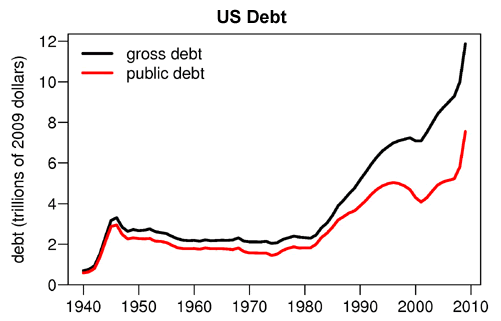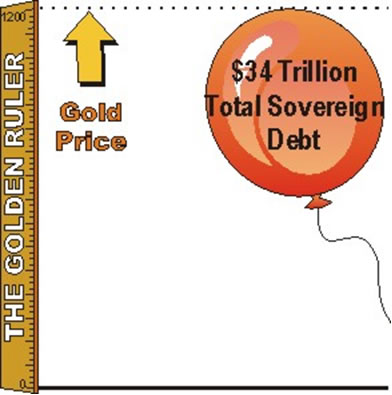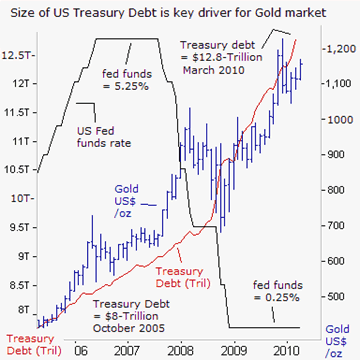Gold Illusory Bubble and the Debt Bubble End Game
Interest-Rates / Global Debt Crisis Jul 14, 2010 - 01:40 AM GMTBy: Darryl_R_Schoon
 When the end-game began, gold was $35 per ounce. Today, gold is $1200.
When the end-game began, gold was $35 per ounce. Today, gold is $1200.
When the end-game is over, gold will be far higher.
Midway through 2010 we are approaching the end of the end-game, the resolution of the monetary imbalances that began in 1971. For more than 2500 years, gold was money: but, in 1971 that changed. After 1971, money was no longer connected to gold. For the first time in history, money had no intrinsic value
After the Bretton Woods Agreement in 1945 until 1971, the world’s currencies were anchored to the US dollar which was convertible to gold. Thus, directly or indirectly, all currencies could be exchanged for gold; but on August 15, 1971 the US cut the ties between the US dollar and gold; and all currencies became fiat.
It was as if someone removed a pin from the axle of international commerce when the US dollar was no longer convertible to gold. Previously, the US dollar was linked to gold, and other currencies were linked to the dollar. Everything was stable. It is no longer so. Once the pin connecting gold and paper money was removed, everything changed. The axle of international commerce began to vibrate and lately it’s been getting much worse. The fear is that the wheels are now about to come off.
Page 9, How to Survive the Crisis and Prosper in the Process
THE BEGINNING OF THE END-GAME
The cutting of ties between money and gold set in motion the extreme monetary instability that was to characterize the 1970s. In 1960, the US prime rate was 5 %. At the end of the decade, the rate was 6.75 %. But when money became fiat in 1971, US rates became extremely volatile, vacillating between 4.50 % and 21.50 % during the next ten years.
In my article America at the Crossroads and the War on Gold, I pointed out the role of former Fed chairman Paul Volker in destabilizing the monetary system. Believed by most to be a “hard-money hero”, Volker was, in fact, the very opposite.
Volker, as under-secretary of the Treasury in 1971, played a critical—and largely unknown role—in the removal of gold from the international monetary system and is therefore responsible for much of the monetary chaos which has since ensued:
From 1969 to 1974 Mr. Volcker served as under-secretary of the Treasury for international monetary affairs. He played an important role in the decisions leading to the U.S. suspension of gold convertibility in 1971, which resulted in the collapse of the Bretton Woods system.
http://en.wikipedia.org/wiki/Paul_Volcker
Appointed as Chairman of the Federal Reserve by President Carter in 1979, Volker was at the helm when inflationary forces he had earlier unleashed almost destroyed the US economy in 1979-1981.
Volker’s draconian raising of interests rates in 1980 was necessary to quell the inflationary fires he had lit in 1971; and although successful, Volker’s role is not dissimilar from others who put out fires they themselves start.
THE END-GAME ACCELERATES
While it was Paul Volker who set the end-game in motion, it was Alan Greenspan, his successor at the Fed, who would greatly accelerate the process by putting US financial markets beyond the reach of government regulators.
Volker was replaced by Greenspan as Fed Chairman because Volker wouldn’t dismantle existing financial regulations as desired by the Reagan White House and Wall Street investment banks. As Nobel Prize winner Joseph Stiglitz later explained:
Paul Volcker, the previous Fed Chairman known for keeping inflation under control, was fired because the Reagan administration didn't believe he was an adequate de-regulator.
In Alan Greenspan, Wall Street got the Fed chairman they wanted, someone who would provide them with an unending flow of central bank credit and who would turn a blind eye as to what they would do with it. Alan Greenspan was Wall Street’s wet dream come true.
During his 19 year tenure as Fed Chairman, Alan Greenspan ushered in an era of loose credit producing massive profits for Wall Street along with two of the largest bubbles in history, the US dot.com and US real estate bubbles.
Greenspan with consummate political timing resigned as Fed Chairman just before his extraordinary credit bubble collapsed. However, a third, even larger bubble which Greenspan nurtured, still has yet to burst. This is the government bond bubble, by far now the largest bubble in history
The enormous government bond bubble was “Fed” by the excessive issuance of credit made possible by the removal of gold from the monetary system, thereby allowing governments to freely borrow what they had just printed.
Once Volker controlled the fires of runaway inflation in 1980/1981, the issuance of government credit and debt exploded upwards under Greenspan’s tenured aegis at the Federal Reserve.
This soon-to-be fatal rise in US debt would not have been possible had the US dollar been tied to gold. This is why both bankers and governments who profit and live by debt oppose a return to the gold standard or any attempt to again tie their currencies to gold.

…a gold standard and a redeemable currency…enables a people to keep the government and banks in check. It prevents currency expansion from getting ever farther out of bounds until it becomes worthless…
Professor Walter E. Spahr, Chairman of the Department of Economics, NYU, 1927-1956
Banker John Exter, present when Volker cut the ties between the US dollar and gold, later commented on the consequences of Volker’s historic decision: The final link between the dollar and gold was broken. The dollar became nothing more than a fiat currency and the Fed [and especially the banks] were then free to continue monetary expansion at will. The result..was a massive explosion of debt
Today, the debt is due and owing and repayment is increasingly in doubt. Economics isn’t rocket science. It’s cause and effect and since the introduction of debt-based money, the primary cause of economic expansion has been credit.
The consequence of credit is its deadly effluvia, debt; and when the issuance of credit can no longer service or roll-over constantly compounding debt, parcus nex, economic death, otherwise known as the end game, ensues.
The enormous amount of government debt—total sovereign debt now totals $34 trillion dollars—can never be repaid. The end of the end-game will come when investors collectively realize this is so. That realization has not yet happened. When it does, for most it will be too late.
THE ILLUSORY GOLD BUBBLE
Some believe gold is a bubble. It is not. The price of gold, however, tracks a bubble and that is why it is mistaken for one.

WHICH ONE’S THE BUBBLE?
THE RULER OR THE BUBBLE?
The real bubble is government debt, not gold. Government debt is a bubble that hasn’t yet burst; one that has grown even more rapidly in the last two years as almost all nations went far deeper into debt after the 2007/2008 global collapse.
..sovereign debts grew by almost 30% in just two years. Sovereigns became the majority of worldwide debt. Several countries doubled their debts from 2007 to 2009 (BIS data)
http://www.calculatedriskblog.com/2010/07/how-large-is-outstanding-value-of.html
This recent meteoric rise in government debt has been matched by a corresponding rise in the price of gold. When government borrowing rose after 2007, the price of gold also rose, from $700 to $1200 per ounce, almost precisely tracking the rise in government debt.

…the ballooning size of the US Treasury’s debt, which hit a record $12.8-trillion last month, has been a steady linchpin supporting the historic rally in the gold market over the past decade. As a general rule of thumb, every $1- trillion of fresh debt issued by the Treasury equates with a $125 /ounce increase in the price of gold. As long as the Fed and G-20 central banks continue to peg ultra-low interest rates, - and G-20 governments continue to flood the debt markets with huge quantities of IOU’s, - it translates into monetization, and the trajectory for the gold market would stay bullish. http://www.sirchartsalot.com/
When the government debt bubble bursts—and it will—gold will not collapse as will bonds and other paper IOUs. When it happens, the collateral damage to the US dollar and fiat currencies may well be fatal and the price of gold—the only safe haven in such times—will explode upwards.
The recently revealed Bank of International Settlement 382 ton gold swap is evidence of gold’s value in such times. Hinted at by Julian D.W. Phillips in his insightful article, Gold Is Back As Money, Michael J. Kosares connected the dots in his post, BIS Swap Signifies A Threat To Europe, Not To Gold, by pointing out that the swap was probably conducted with Portugal..
Portugal, whose gold reserves equal ( or rather equaled) 382 tons, badly needs to refinance its debt and when investors no longer trust sovereign bonds, gold is far more preferable as collateral than a government’s promise to repay.
Note: In the swap, the BIS most likely used commercial banks as intermediaries in order to disguise central bank use of gold as financial collateral.
The European debt crisis marks the beginning of the end of the government debt bubble. Only a false sense of confidence is now supporting sovereign bond markets. In the spring of 2010 that confidence was shaken; and, someday, it will disappear entirely.
We live in interesting times. We are in the end-game.
Buy gold, buy silver, have faith.
By Darryl Robert Schoon
www.survivethecrisis.com
www.drschoon.com
blog www.posdev.net
About Darryl Robert Schoon
In college, I majored in political science with a focus on East Asia (B.A. University of California at Davis, 1966). My in-depth study of economics did not occur until much later.
In the 1990s, I became curious about the Great Depression and in the course of my study, I realized that most of my preconceptions about money and the economy were just that - preconceptions. I, like most others, did not really understand the nature of money and the economy. Now, I have some insights and answers about these critical matters.
In October 2005, Marshall Thurber, a close friend from law school convened The Positive Deviant Network (the PDN), a group of individuals whom Marshall believed to be "out-of-the-box" thinkers and I was asked to join. The PDN became a major catalyst in my writings on economic issues.
When I discovered others in the PDN shared my concerns about the US economy, I began writing down my thoughts. In March 2007 I presented my findings to the Positive Deviant Network in the form of an in-depth 148- page analysis, " How to Survive the Crisis and Prosper In The Process. "
The reception to my presentation, though controversial, generated a significant amount of interest; and in May 2007, "How To Survive The Crisis And Prosper In The Process" was made available at www.survivethecrisis.com and I began writing articles on economic issues.
The interest in the book and my writings has been gratifying. During its first two months, www.survivethecrisis.com was accessed by over 10,000 viewers from 93 countries. Clearly, we had struck a chord and www.drschoon.com , has been created to address this interest.
Darryl R Schoon Archive |
© 2005-2022 http://www.MarketOracle.co.uk - The Market Oracle is a FREE Daily Financial Markets Analysis & Forecasting online publication.



